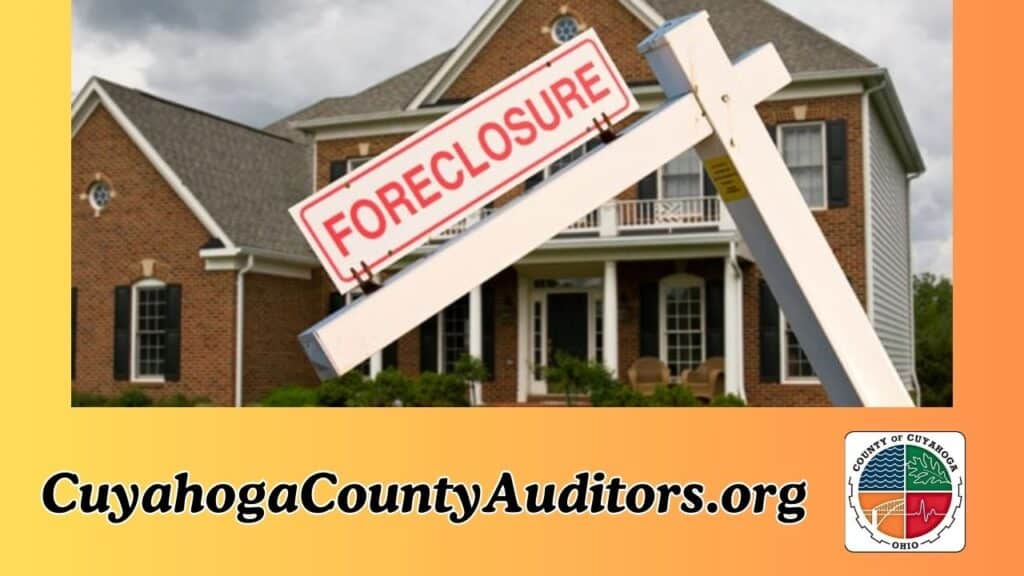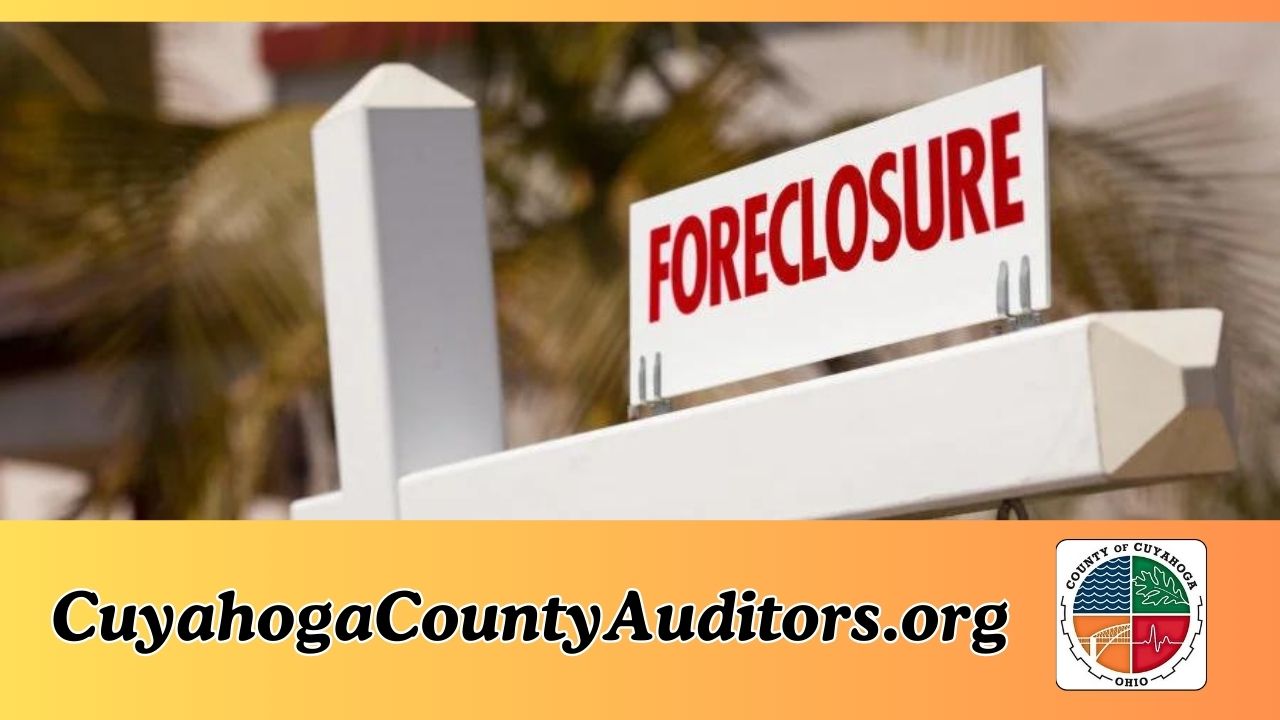Wondering about the foreclosure process in Cuyahoga County? It’s simple. If a homeowner in Cuyahoga County, Ohio, misses mortgage payments, the lender can start a legal process called foreclosure.
This lets the lender take the property and sell it to get back the unpaid loan balance. The foreclosure process in Cuyahoga County has a specific timeline and steps, giving everyone involved a chance to solve the issue or contest the foreclosure.
In this article, we’ll explain the foreclosure process in Cuyahoga County step by step. Whether you’re facing foreclosure, interested in buying foreclosed properties, or just want to know more, this guide has everything you need to know.

What is Foreclosure?
Foreclosure happens when a borrower can’t pay their mortgage. It lets the lender sell the property to get back the loan balance. In Ohio, foreclosure is a judicial process, meaning it goes through the courts.
Key Terms in Foreclosure
- Lender: The bank or financial institution that provides the mortgage loan.
- Borrower: The homeowner who has taken out the mortgage and is responsible for making payments.
- Default: Failing to meet the mortgage payment terms.
- Judicial Foreclosure: A type of foreclosure that requires the lender to file a lawsuit in court.
- Auction: The public sale of a foreclosed property to the highest bidder.
Overview of the Foreclosure Process in Cuyahoga County
The foreclosure process in Cuyahoga County, Ohio, follows these steps:
- Missed Payments
- Notice of Default
- Filing a Foreclosure Lawsuit
- Foreclosure Judgment
- Sheriff’s Sale (Auction)
- Redemption Period
- Eviction or Sale Confirmation
We’ll explore each step to understand the process and the options for homeowners and lenders.
1. Missed Payments
The foreclosure process starts when a homeowner misses a mortgage payment. Lenders usually give a grace period before declaring a borrower in default. If multiple payments are missed (often three or more), the lender may start the foreclosure process.
Key Points:
- Lenders often try to help homeowners by suggesting payment solutions, like loan modification or forbearance, before filing for foreclosure.
- If the borrower can’t fix the issue, the lender will move on to the next step.
2. Notice of Default
When a borrower keeps missing payments, the lender sends a Notice of Default. This notice tells the homeowner they’re in default and face foreclosure unless the debt is paid. This step gives the homeowner a chance to make payments or find other ways to avoid foreclosure.
3. Filing a Foreclosure Lawsuit
Ohio is a judicial foreclosure state. This means the lender must file a lawsuit in court to start foreclosure. After the lawsuit is filed, the borrower is served with a Summons and Complaint, giving them a chance to respond.
The Borrower’s Options After Being Served:
- Answer the Complaint: The borrower can contest the foreclosure by filing an answer in court. This may delay the process.
- Negotiate with the Lender: Some borrowers try to work with the lender to find an alternative solution, such as refinancing, loan modification, or a short sale.
- Do Nothing: If the borrower doesn’t respond, the lender will seek a default judgment from the court.
4. Foreclosure Judgment
If the borrower can’t pay, the court will rule in favor of the lender. This ruling lets the lender sell the property at a Sheriff’s Sale (a public auction).
5. Sheriff’s Sale (Auction)
The Sheriff’s Sale is a public auction where the foreclosed property is sold to the highest bidder. In Cuyahoga County, these auctions are online. The goal is to sell the property to recoup the unpaid loan balance. Once sold, the proceeds go to the lender to pay off the debt, and any excess funds (if applicable) are given to the borrower.
Steps Involved in a Sheriff’s Sale:
- The auction is publicly announced, providing details about the property.
- Interested buyers can bid on the property online.
- The highest bidder wins, but the sale is not final until the court confirms it.
6. Redemption Period
Ohio law allows for a Redemption Period, where the homeowner can pay off the debt and reclaim the property, even after the Sheriff’s Sale. But, once the sale is confirmed by the court, this option is no longer available.
7. Eviction or Sale Confirmation
If the property is sold and the court confirms the sale, the borrower must vacate the property. If they fail to do so, an eviction notice will be issued, and the Sheriff’s Office will carry out the eviction.
Key Timeframes in the Foreclosure Process in Cuyahoga County
The foreclosure process can take several months or even years, depending on various factors. Here is a general timeline:
| Step | Timeframe |
|---|---|
| Missed Payments | 30 to 90 days after missed payment |
| Notice of Default | Typically 30 days after missed payments |
| Filing of Foreclosure Lawsuit | 2 to 3 months after default |
| Foreclosure Judgment | 1 to 6 months after lawsuit filed |
| Sheriff’s Sale | 4 to 8 months from lawsuit |
| Eviction or Confirmation | Within 30 days of sale confirmation |
Avoiding Foreclosure: What Homeowners Can Do
If you’re a homeowner in Cuyahoga County and are facing foreclosure, it’s important to know your options. While the process may seem daunting, there are several steps you can take to avoid foreclosure and protect your home.
1. Loan Modification
One of the most common ways to avoid foreclosure is through a loan modification. This is when the lender agrees to change the terms of your loan to make payments more manageable. This could include lowering the interest rate, extending the loan term, or even forgiving some of the debt.
2. Forbearance
With forbearance, the lender agrees to temporarily reduce or suspend your mortgage payments. This can provide short-term relief while you work to improve your financial situation.
3. Repayment Plan
Lenders may offer a repayment plan. This allows you to catch up on missed payments by spreading the amount over several months.
4. Short Sale
If you owe more on your mortgage than the property is worth, a short sale might be an option. In a short sale, the lender agrees to let you sell the property for less than what is owed, which can help you avoid foreclosure.
5. Deed in Lieu of Foreclosure
Another option is a deed in lieu of foreclosure. This is where you voluntarily transfer ownership of the property to the lender in exchange for being released from the mortgage debt.
Loan Modification vs. Forbearance
| Option | Description | Pros | Cons |
|---|---|---|---|
| Loan Modification | Permanent change in loan terms to lower payments | Long-term solution | May affect credit score |
| Forbearance | Temporary suspension or reduction of payments | Immediate relief | Payments resume later, potentially higher |
Judicial vs. Non-Judicial Foreclosure
| Feature | Judicial Foreclosure (Cuyahoga County) | Non-Judicial Foreclosure (Other States) |
|---|---|---|
| Requires Court Action | Yes | No |
| Length of Process | Longer due to court involvement | Typically faster |
| Homeowner’s Ability to Contest | Yes, more opportunities to contest | Fewer opportunities to challenge |
| Public Auction | Yes | Yes |
Buying Foreclosed Properties in Cuyahoga County
Buying foreclosed homes in Cuyahoga County can be a good deal. But, it’s important to know the risks. These homes are often sold as-is and may need repairs.
Steps to Buy a Foreclosed Property
- Find Foreclosure Listings: Look for listings on the Cuyahoga County Sheriff’s website or real estate sites.
- Attend a Sheriff’s Sale: Go to the Sheriff’s Sale to bid on a property.
- Finalize the Sale: If you win, complete the purchase and ensure all paperwork is done.
Risks of Buying Foreclosures:
- Property Condition: Foreclosed homes are sold as-is, so you won’t know their condition until after buying.
- Title Issues: There could be liens or unpaid taxes on the property.
Conclusion
The foreclosure process in Cuyahoga County is a legal way to solve mortgage defaults. It helps both homeowners and lenders. Knowing the steps can make you feel more confident, whether you’re trying to avoid foreclosure or buy a foreclosed home.
Homeowners can avoid foreclosure by acting early and looking into options like loan modification or forbearance. For buyers, foreclosed homes in Cuyahoga County can be a great deal. But, it’s important to do your research and consider the risks.






